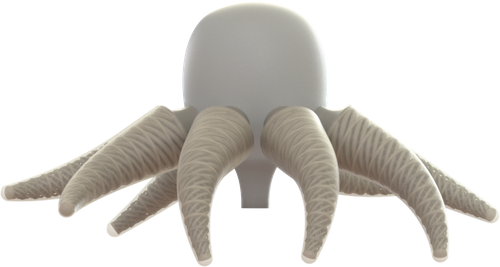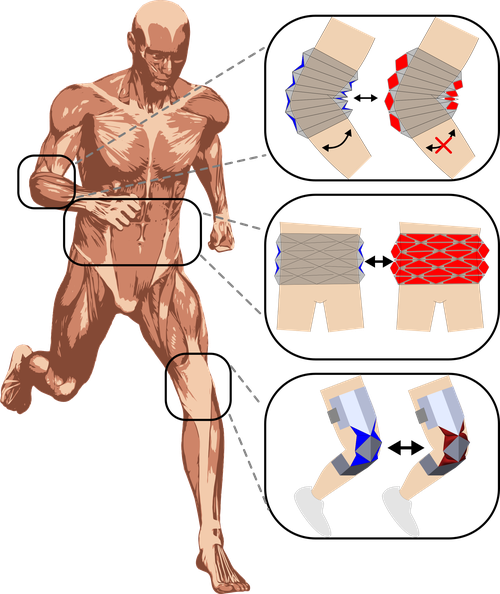Research Projects
SCRAMS: Soft, Curved, Reconfigurable, Anisotropic Mechanisms
Introduction
Soft Curved Reconfigurable Anisotropic Mechanisms (SCRAMs) are a new class of soft robotic technology that will enable new multi-functional soft robots with reconfigurable actuation and shapes.
The key to the proposed technology is the ability to change the mechanical properties of a thin-walled structure by changing its local curvature. For example, curving a flat sheet of paper along one direction greatly increases its stiffness in the other two directions. Exploiting the coupling between curvature and mechanical behavior in planar materials will enable the design, modeling, and control of reconfigurable soft robots. Based on this concept, we have proposed two different models made from soft materials that can all be used to alter the mechanical behavior via tuning the structural stiffness. These three models are thin-walled cylindrical tubes, and curve beams.
This work is supported by NSF Award #1935324
CAREER: Dynamic Modeling and Fabrication of Compliant Material Systems for On-Demand Specialist Robots

This Faculty Early Career Development (CAREER) grant will make it possible to develop cost-effective, specialist robots that can be prototyped by a non-expert in a matter of hours. The goal of this project is to make robots more ubiquitous, accessible, and tunable for newcomers to robotics and for applications in industry, education, and academic research. Achieving this goal requires a shift towards more affordable materials, accessible fabrication strategies, and assistive design software that considers the particular dynamics of cost-efficient motors and materials, as well as the needs of specific applications. The results of this project will impact fields in which specialization is desirable, such as assistive robotics for the elderly, custom agricultural applications, and trash pickup in smart cities. The robots developed through this project will also serve as an affordable starting point for children to compete in after-school robotics competitions organized by local, youth-focused nonprofits. In addition, the models and templates developed for this project will be integrated into college-level robotics curricula, permitting students to venture deeper into advanced robotics topics earlier in their studies.
This work is supported by NSF Award #1944789
Students: Fuchen Chen, Cole Brauer
A Wearable Hybrid Robotic Suit for Self-Actualization and Well-Being
This project proposes a wearable hybrid robotic system to address mobility issues that occur in aging populations. The goal of this system will be to support and guide the wearer through every day tasks, improving stability to reduce the risk of falls and subsequent injury. Our approach takes a three-thrust approach: 1) understanding through human biomechanics studies where and how interventions on the human body can have the highest impact, 2) the design of a suit that reconfigures itself on demand to provide external load pathways to the ground while staying transparent to the wearer in other use-cases, and 3) decision on how to reconfigure and use the suit informed by predictive biomechanics and sensor fusion approaches.
This work is supported by the ASU Global Kaiteki Center
Octopus-Inspired Soft Hydrogel Robots

Overview
We are working to create a framework for design, rapid prototyping and control of robust, energy-efficient, autonomous soft arms with octopus-inspired distributed neuromuscular sensing and actuation. The arms will be capable of continuous deformation through the use of hydrogel “muscles” and distributed sensing through the use of embedded silver “neuron” interconnections. Such a unique octopus-inspired design forms a built-in local “sensing-actuation” feedback loop to achieve adaptive reconfiguration in response to the local environment. Such local adaptation will enable the robot to perform high-level tasks such as locomotion and reversible adhesion without coordination from a central controller in a highly accurate, rapid, and energy-efficient way. This study will also produce fundamental principles and theory for the modeling and control of soft robots in a way which leverages their unique capabilities and is inspired by how cephalopod appendages interact with their environment.
This work was supported by Office of Naval Research Award N00014-17-1-2117
onr
The Efficiency of Spine Stiffness in regards to Anguilliform Locomotion
Fish come in varying shapes, sizes, and ecosystems that lead to a multitude of different modes of swimming. To categorizes these different methods, fish are separated by fin and body motion. In particular the order of fish Anguilliformes or ‘eel-like’ locomotion utilizes a large portion of their body to produce thrust while swimming known as undulatory locomotion [1]. Due to the developments of high-speed video capture, research with in the past two decades have been able to understand eel locomotion, kinematics, and hydrodynamics. These results have given us more accurate models for Anguilliformes and data about the efficiency, stiffness, and kinematics of their swimming behaviors.
This project is funded as part of a Barrett Honors thesis.
Students: Anson Kwan
Low-Cost Hands-On Engineering Projects and Curriculum for Elementary School Level Children
Elementary students have had a harder time staying engaged in the material during class time, especially since the start of Covid, whether they are online or in-person. Due to the virus, schools require there be enough materials for each individual student to work with so that they can all participate in the activity. Since the schools and teachers generally do not get enough funding, the teachers have to resort to doing the activity themselves under the document camera. Hands-on activities generally help keep the students involved in the curriculum and help them to remember what they have learned. In order to make sure every student can have their own materials, the project kits need to be low-cost and easily accessible.
This project is funded as part of a Barrett Honors thesis.
Students: Jade Heun



